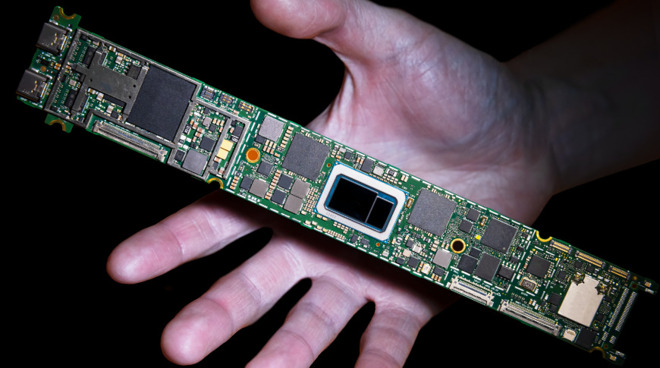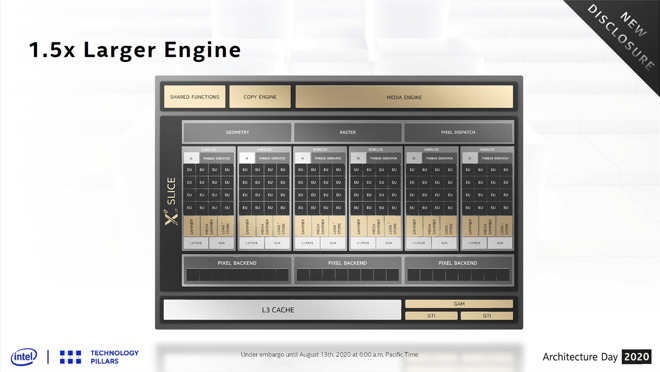Intel details power efficiencies of its upcoming Xe LP graphics architecture
More details about Intel's plans for improved graphics onboard its processors have been revealed, with the Xe LP graphics destined for Tiger Lake processors seemingly going to be comparable to AMD's GPU technology in terms of performance, though it remains to be seen if Apple will use it before fully switching to Apple Silicon.

A board featuring an Intel Tiger Lake processor.
While previously a look at Intel's upcoming mobile processors would include a discussion about what could be included in future MacBook refreshes, this may not be the case for the Xe LP and Tiger Lake. Intel has suggested the first Tiger Lake processors could ship before the end of 2020, but it is starting to seem unlikely that it will even be used by Apple at all.
During WWDC 2020, Apple announced it was migrating Macs and macOS away from using Intel processors to its own Apple Silicon, chips designed and produced by Apple itself. Apple intends to launch its first Apple Silicon products before the end of 2020, and hopes to shift its entire Mac lineup over to using it within two years.
This does mean that for the moment Apple will continue to use Intel chips in its products, so these new details could yet be relevant. Yet the fact that Apple Silicon is on the horizon and the gradual transition to it gives Apple less of an incentive to perform major refreshes of its products that use Intel's processors. It is also unlikely that consumers will want to acquire Intel-based Macs down the line if they will be replaced by Apple Silicon alternates within two years of purchase.
Apple may still refresh Macs with new processors, but given its own schedule and Intel's penchant for delaying processor releases, it seems more probable that Apple will elect to use a current-generation processor rather than work to incorporate another generation.
In January, back before we knew Apple Silicon was coming, Intel provided information about its Tiger Lake processors and the integrated Xe architecture it would use, one that could provide a considerable boost to graphics on mobile devices. During its recent Intel Architecture Day, Intel offered even more plans for where its GPU architecture will be heading in the future.
Xe LP is a low-powered version of the Xe architecture aimed at notebooks and mobile devices rather than the Xe HP and Xe HPC variants aimed at data centers and servers and the Xe HPG as potential discrete graphics cards for gaming enthusiasts. As an entry-level solution, it will be used on processors intended for lower-powered systems.
The chip maker anticipates running Xe LP with thermal design point designs of between 10 watts and 30 watts, shared with the CPU, Tom's Hardware reports. To accomplish this at low power needs, Intel has worked to improve not only its floating-point operations per second (FLOPS), but also improving the performance per FLOP and cutting the power needed.
Intel claims Xe LP will run better in terms of performance than its previous Gen 11 graphics, with it capable of running at higher frequencies and with better performance at the same voltage. Alternately, it can also provide comparable performance to Gen11 when using lower amounts of power.
Processor improvements start with Intel packing 50% more execution units (EUs) into the GPU than Gen11 versions. When put together with higher clock speeds, it is thought Xe LP will be twice as fast as the previous generation.

An overview of Intel's Xe LP architecture.
While Gen11 used two arithmetic logic units (ALUs) that were 4-wide and split work so one was used for floating-point and integer tasks while the other used enhanced math, Xe instead has each EU running to an 8-wide vector unit running the floating-point and integer calculations. A separate enhanced math unit is run concurrently with the integer pipeline, with the two EUs also sharing a single thread controller.
Switching to provide floating-point and integer work across eight ALU pipelines will effectively double the performance from the start. There is also added support for Int16 and 4x Int8 calculations as well, along with an L1 cache to reduce latency and demands on L3 cache, with the latter also doubled to 16MB.
There is also added support for end-to-end compression of data, which is said to be better than the delta color compression employed by AMD and Nvidia. This support can reduce the bandwidth and power requirements further, making it more amenable to high-performance tasks.
Other updates include support for up to four displays, DisplayPort 1.4b and HDMI 2.0 support, an upgraded Media Engine with support for four 4K60 displays, full AV1 decode acceleration, and the ability to decode seven 4K60 HEVC streams concurrently.
There is also, though, the fact that Intel is markedly behind its own projections of where its processors would be by now. It may be that Apple has moved to its own processors because doesn't expect the situation to improve.
It's reportedly also because of Intel quality assurance being poor. Apple Silicon will need to deliver on its promise of better performance, but it's at least likely to meet Apple's schedules and quality control.

A board featuring an Intel Tiger Lake processor.
While previously a look at Intel's upcoming mobile processors would include a discussion about what could be included in future MacBook refreshes, this may not be the case for the Xe LP and Tiger Lake. Intel has suggested the first Tiger Lake processors could ship before the end of 2020, but it is starting to seem unlikely that it will even be used by Apple at all.
During WWDC 2020, Apple announced it was migrating Macs and macOS away from using Intel processors to its own Apple Silicon, chips designed and produced by Apple itself. Apple intends to launch its first Apple Silicon products before the end of 2020, and hopes to shift its entire Mac lineup over to using it within two years.
This does mean that for the moment Apple will continue to use Intel chips in its products, so these new details could yet be relevant. Yet the fact that Apple Silicon is on the horizon and the gradual transition to it gives Apple less of an incentive to perform major refreshes of its products that use Intel's processors. It is also unlikely that consumers will want to acquire Intel-based Macs down the line if they will be replaced by Apple Silicon alternates within two years of purchase.
Apple may still refresh Macs with new processors, but given its own schedule and Intel's penchant for delaying processor releases, it seems more probable that Apple will elect to use a current-generation processor rather than work to incorporate another generation.
Could still appear in Macs
In January, back before we knew Apple Silicon was coming, Intel provided information about its Tiger Lake processors and the integrated Xe architecture it would use, one that could provide a considerable boost to graphics on mobile devices. During its recent Intel Architecture Day, Intel offered even more plans for where its GPU architecture will be heading in the future.
Xe LP is a low-powered version of the Xe architecture aimed at notebooks and mobile devices rather than the Xe HP and Xe HPC variants aimed at data centers and servers and the Xe HPG as potential discrete graphics cards for gaming enthusiasts. As an entry-level solution, it will be used on processors intended for lower-powered systems.
The chip maker anticipates running Xe LP with thermal design point designs of between 10 watts and 30 watts, shared with the CPU, Tom's Hardware reports. To accomplish this at low power needs, Intel has worked to improve not only its floating-point operations per second (FLOPS), but also improving the performance per FLOP and cutting the power needed.
Intel claims Xe LP will run better in terms of performance than its previous Gen 11 graphics, with it capable of running at higher frequencies and with better performance at the same voltage. Alternately, it can also provide comparable performance to Gen11 when using lower amounts of power.
Processor improvements start with Intel packing 50% more execution units (EUs) into the GPU than Gen11 versions. When put together with higher clock speeds, it is thought Xe LP will be twice as fast as the previous generation.

An overview of Intel's Xe LP architecture.
While Gen11 used two arithmetic logic units (ALUs) that were 4-wide and split work so one was used for floating-point and integer tasks while the other used enhanced math, Xe instead has each EU running to an 8-wide vector unit running the floating-point and integer calculations. A separate enhanced math unit is run concurrently with the integer pipeline, with the two EUs also sharing a single thread controller.
Switching to provide floating-point and integer work across eight ALU pipelines will effectively double the performance from the start. There is also added support for Int16 and 4x Int8 calculations as well, along with an L1 cache to reduce latency and demands on L3 cache, with the latter also doubled to 16MB.
There is also added support for end-to-end compression of data, which is said to be better than the delta color compression employed by AMD and Nvidia. This support can reduce the bandwidth and power requirements further, making it more amenable to high-performance tasks.
Other updates include support for up to four displays, DisplayPort 1.4b and HDMI 2.0 support, an upgraded Media Engine with support for four 4K60 displays, full AV1 decode acceleration, and the ability to decode seven 4K60 HEVC streams concurrently.
Apple Silicon
We have no possible way of comparing Intel's claims of future performance with Apple's actually far less specific claims of the same thing for Apple Silicon. Publicly, Apple spoke of wanting to create Macs with significantly faster and ever-improving performance, so we can expect that the aim at least is to match or exceed what Intel is promising.There is also, though, the fact that Intel is markedly behind its own projections of where its processors would be by now. It may be that Apple has moved to its own processors because doesn't expect the situation to improve.
It's reportedly also because of Intel quality assurance being poor. Apple Silicon will need to deliver on its promise of better performance, but it's at least likely to meet Apple's schedules and quality control.

Comments
Nothing Raja has will touch either AMD or Nvidia.